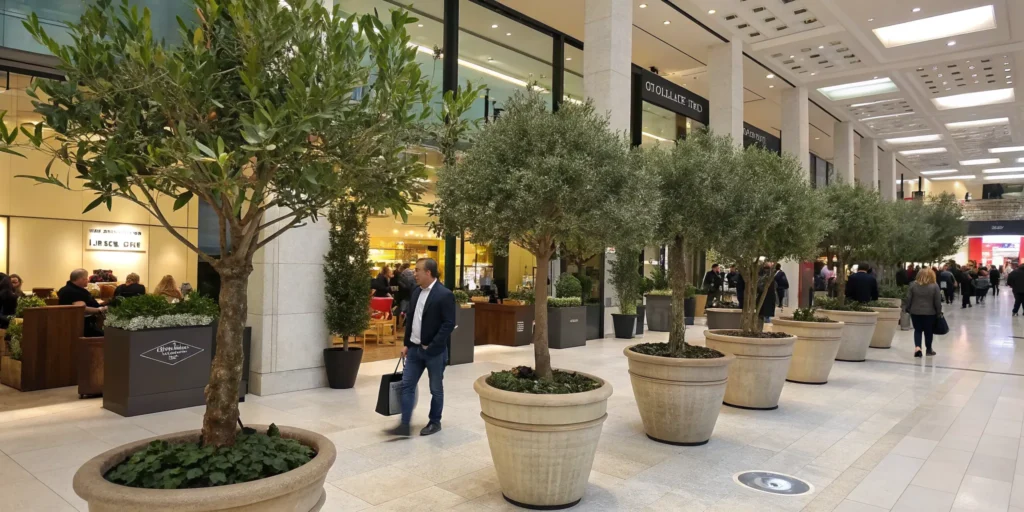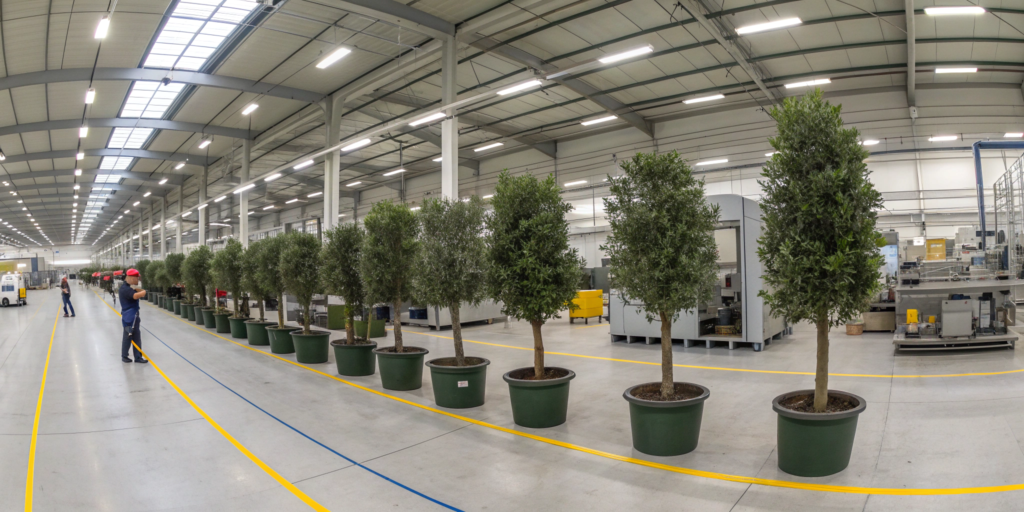We all know that olive trees bring a touch of Mediterranean charm to any space. Now their popularity in both home décor and commercial design is rapidly rising. But choosing between real and artificial olive trees isn’t always easy. Real trees require precise light, climate control, and ongoing maintenance. Many spaces simply cannot provide these conditions. On the other hand, some buyers worry that artificial options may look fake or lack natural texture.
This leaves homeowners, designers, and landscapers with a practical question: Should you invest in a real olive plant or choose an artificial alternative?Let’s walk through this article. It will help you weigh the pros and cons to make a confident choice.
Real Olive Trees: Advantages and Drawbacks
Real olive trees are beloved for their authentic beauty and connection to nature. Here’s what you need to know about them.
Advantages of Real Olive Trees:
Authenticity: Nothing beats the real thing. Real olive trees have unique growth patterns. They can change leaf colors with seasons. Artificial versions can’t fully replicate their natural textures. Their gnarled trunks and delicate stems tell a story of growth, adding warmth to gardens or indoor spaces.
Environmental Benefits: These trees help reduce carbon dioxide levels and improve air quality. They also provide food and shelter for birds and beneficial insects. In this way, it can support biodiversity in your backyard.
Emotional Connection: When you water it, prune its branches and watch it grow, you may feel deeply satisfied. Many plant lovers find joy in caring for a living thing. This not only enhances happiness, but also cultivates a sense of responsibility.

Drawbacks of Real Olive Trees;
High Maintenance: Real olive trees need regular care. They require proper watering (not too much, not too little), pruning to keep their shape, and pest control to avoid bugs like olive fruit flies. If you’re busy or new to gardening, this upkeep can feel overwhelming.
Climate Needs: Olive trees thrive in Mediterranean climates. That means sunny, dry summers and mild winters. Ideally, they require typically at least 6 hours of direct sunlight each day. They also need proper fertilization and watering during the growing. Several studies have shown that when olive trees are planted in non-typical climate zones, their survival rate growth status significantly decrease. So, if you are planting olive trees in a non-Mediterranean climate, you need to provide extra care to reduce the risks.
Allergens and Pests: Real olive trees produce pollen, which can trigger allergies in sensitive people. They also attract pests like olive fruit flies and scale insects. These pests can damage the leaves and stems. So it requires extra effort to keep them healthy.
Artificial Olive Trees: Pros and Cons Explained
Artificial olive trees have become popular for their low-maintenance charm. Modern artificial olive trees use premium materials like PE or silk leaves with individually molded details. Let’s dive into their benefits and downsides.
What are the benefits of false olive trees?
Low Maintenance: Faux olive trees are perfect for busy people or those without a green thumb. They don’t need watering, pruning, or fertilizing. This means you can save about 2-3 hours of plant maintenance time per week.
Versatility: They work anywhere, no matter indoors or outdoors, bright rooms or dim corners. Unlike real trees, they aren’t fussy about light or climate. You can place a small potted faux olive tree on your desk or a large one in your living room. You can even put a tall outdoor model on your patio. If you travel frequently or work long hours, realistic faux olive trees maintain their appearance whether you’re home or away for months.
Allergy-Friendly: Artificial olive trees don’t produce pollen, so they won’t trigger allergies. They’re a great way to bring greenery into your home if you or your family have sensitivities. At the same time, they’re also ideal for healthcare facilities, schools, restaurants, and any public spaces where allergen control matters.
Realistic Looks: High-quality faux olive trees are made to mimic real ones. They have lifelike leaves. These leaves are often made of silk or PE. They have textured trunks. Even green or black fake olives look just like the real fruit. Modern imitation techniques have advanced so much that some are so realistic. You might have to touch the leaves to tell they’re fake!
Long-Lasting: With proper care, faux olive trees can stay looking fresh for years. They don’t lose leaves in winter or die from bad weather. All these make them one of the most durable decor choices.

What are the disadvantages of artificial olive trees?
Initial Cost: The upfront cost of quality artificial olive trees runs higher than live plants, and cheap versions look obviously fake. A premium 6-foot artificial olive tree costs more initially, but a live one of the same size is cheaper upfront. However, real trees require ongoing care and additional expenses. So, you will see this comparison will shift in the next few months. Therefore, in the long run, high-quality artificial olive trees will save you more money and effort.
Potential Fading: If you put your artificial olive tree outdoors without UV protection, the sun might fade its leaves over time. Look for UV-resistant models, if you want to use them outside. It will keep their vibrant color longer.
Less Emotional Connection: Unlike real trees, faux ones don’t grow or change. You won’t get the satisfaction of nurturing a living thing. This is a connection that some people may genuinely miss.
Should l get a real or fake olive tree?
The answer depends on your lifestyle:
Choose a REAL Olive Tree if:
For Homeowners: You live in a true Mediterranean climate (Zone 8-10). You genuinely enjoy the hobby of gardening. You have enough horticultural knowledge the time for consistent watering, pruning, and pest control.
For Designers & Landscapers: Your project is in an ideal climate zone. The client has clearly agreed to arrange ongoing professional gardening maintenance. And they set aside a budget for it. Real trees are suitable for projects that prioritize 100% authenticity. At the same time, they have fully considered the high maintenance risks.

Choose a FAKE Olive Tree if:
For Homeowners: You are busy. You have allergies. You live in an unsuitable climate where is too cold, too humid, or not enough light. Or you simply want guaranteed, zero-maintenance decor.
For Designers & Landscapers: In order to guarantee a specific aesthetic for a client or property, you need a risk-free, durable, and scalable solution. If your projects are in commercial lobbies, rental communities, or indoor spaces with low light, faux trees are the ideal choice. And they need zero-maintenance and have consistent, long-term beauty. They eliminate all risks of disease, death, and recurring labor costs.
Many people also mix the two! For example, a large real olive tree in the backyard and a small potted faux one indoors.
Now more and more homeowners and business choose decorative artificial plants. In high-traffic commercial spaces and rental properties, people are also increasingly choosing artificial trees. This is because ease of maintenance is more important than the realism of natural plants. Furthermore, high-end artificial plants have achieved an extremely high level of realism.

How long will a faux olive tree last?
Generally speaking, high-quality artificial olive trees last 5-10 years indoors and 3-5 years outdoors with UV protection. The faux olive tree’s longevity depends on material quality, placement location, and basic maintenance. As the premium artificial olive trees are made with UV-resistant PE leaves and natural wood trunks, they have a longer lifespan than cheaper plastic artificial trees.
Indoors luxury artificial olive trees maintain their appearance virtually indefinitely with minimal care. The main factors affecting lifespan are dust accumulation (easily cleaned) and physical damage from moving or accidents. Trees placed away from direct sunlight and heat sources can look fresh for a decade or more.
Outdoor artificial olive trees face harsher conditions. UV radiation is the primary threat. Sunlight breaks down synthetic materials over time. It causes color fade and brittleness. UV-stabilized trees incorporate protective additives during manufacturing. It can help to extend outdoor life to 5-7 years before noticeable fading occurs. Trees placed in covered patios or partially shaded areas last longer than those in full sun.
With proper care, your investment in a quality faux olive tree pays dividends. However, real olive trees may die completely within 1-2 years if climate or care conditions aren’t ideal. The predictable longevity of artificial trees helps you plan décor budgets more accurately.
Why are faux olive trees so expensive?
Faux olive trees cost more than some other fake plants because of their quality materials and craftsmanship. The best ones use:
Realistic Materials: Silk or PE leaves can mimic the texture and color of real olive leaves. Our factory creates molds directly from living plant samples, then individually paint subtle color variations to mimic nature’s complexity. They make silvery undersides, green tops with brown tips. This process is labor-intensive compared to stamping out uniform plastic leaves.
Detailed Trunks: Premium fake olive trees use actual dried wood as their trunk base. They can provide authentic bark texture and visual realism. Each trunk is unique, selected and treated to prevent cracking. Lower-priced alternatives use molded plastic or resin trunks that look artificial up close.
Handmade Details: Many high-end faux olive trees are assembled by hand. Craftspeople individually attach hundreds of leaf stems to wire branches. Then they shape each branch to create natural, asymmetric forms. They adjust foliage density, angle branches realistically, and position olive fruits for visual appeal. This craftsmanship requires 4-6 hours per tree for premium models. While it needs only 30 minutes for cheap faux trees.
Durability Features: High-quality artificial olive trees rely on true UV resistance for outdoor use. For indoor safety, we add fire-retardant treatment into the raw material. At our factory, commercial-grade UV inhibitors are infused directly into the leaves during manufacturing. This process ensures long-term protection against fading, cracking, and discoloration.

In contrast, low-cost products on the market often use surface-level UV sprays. This process will wash off quickly and provide minimal durability. The advanced treatments significantly extend product lifespan and performance. At the same time, they increase production costs. For professional projects, however, this investment ensures reliability and long-term value.
Now consumers are increasingly recognizing the value of premium artificial plants. Sales of higher-end options is outpacing cheaper alternatives in recent years. This is because buyers recognized that realistic appearance and longevity justify higher initial investment. When you calculate cost per year of use, expensive faux olive trees actually cost less than repeatedly replacing cheap versions.
For a deeper exploration of what determines the cost of quality artificial greenery, read our full guide.
Ready to Transform Your Space with a Perfect Olive Tree?
Whether you choose the timeless charm of a real olive tree or the effortless elegance of an artificial one, the right decision enhances your space for years to come. If you’re ready for Mediterranean-inspired décor without the maintenance demands, you can explore our collection of premium realistic faux olive trees. These trees feature natural wood trunks, hand-crafted foliage, and guaranteed UV protection.
Don’t wait. Bring the timeless beauty of olive trees today!
FAQs about Artificial Olive Trees:
1: Do fake olive trees look real?
Yes! High-quality fake olive trees can look very real. Look for models with:
Lifelike leaves (silk or PE) in silvery-green hues.
Textured trunks that mimic real wood.
Branches that are flexible and can be shaped.
Fake olives (green or black) for extra authenticity.
2. How to clean artificial olive trees?
Cleaning faux olive trees is easy. You can use a soft cloth, feather duster, or even a vacuum with a brush attachment to remove dust from leaves and branches. For stains or sticky spots, dampen a cloth with warm water and mild soap. Gently wipe the leaves and stems, then dry with a clean cloth. Don’t use bleach or strong cleaners. They can damage the leaves or fade the color.
If your faux olive tree is outside, you can rinse it with a low pressure hose (not high pressure) and let it air dry. Make sure it’s UV-resistant first!


